Although there are a number of equally sacred spots for Jess Franco fanatics scattered around Western Europe, Franco returned to Calpe to film again and again throughout his career, giving it, I think, a pretty good claim to being the director’s spiritual home – helped no doubt by the fact that Alicante and the Costa Blanca was also his actual home and base of operations for the last thirty plus years of his life.
Whilst it is still to some extent a working port town with a small fishing fleet, Calpe in 2016 is largely resigned to its status as a tourist town, if thankfully one with a slightly more refined and low key character than the nearby ‘fleshpots’. The gleaming, recently built towers of the town centre and shopping district have a rather bland, comfortable feeling about them, which extends unchallenged through the rows of identikit tourist restaurants that line the pristine beach-front, leading to the slightly lower and shabbier high rises of the older hotels around the harbour. (And who knows what kind of shenanigans Franco might have filmed within them over the year, although unfortunately trying to identify forty year old hotel interiors is likely to prove a pretty tough gig.)
One feature of Calpe that is definitely neither bland nor comforting however is the astonishing Peñón de Ifach, the titanic limestone rock formation that overlooks the harbour, its shape visible along the coastline for miles in either direction.
Wherever you are in Calpe, the Peñón will invariably draw your attention – it dominates the town to an extent that is almost surreal, with its sheer size becoming almost head-spinning at close quarters. As such, it’s no wonder that it requently caught the eye of Jess Franco’s ever-roving camera lens, often appearing like some weird totem before he pans down and across into an establishing shot of the harbour area.
This is how the Peñón de Ifach appears in what is (to my knowledge) the earliest film Franco shot around Calpe, 1966’s Cartes Sur Table / ‘Attack of the Robots’:
And this is as close as I could get to recreating that shot in September 2016:
Spinning around to a reverse shot meanwhile, this harbour will be all too familiar to Francophiles…
…and, I’m pretty sure that this must be the road on which the ‘final girl’ character in Bloody Moon (1981) has a run-in with an unconvincing falling ‘boulder’ and subsequently instigates a health & safety-related altercation with the local police. No doubt she’d be pleased to see they now have a warning sign up there.
Turning back toward the ocean meanwhile, the lighthouse at the end of the spit that forms the entrance to Calpe’s harbour appears to have been slightly remodelled since 1973 (perhaps as a result of storm damage?), but is still clearly recognisible as the port from which Robert Woods and Tania Busselier cast off, bearing Lina Romay to the “island” of Count and Countess Zaroff in that year’s Countess Perverse.
Although both ‘Countess Perverse’ and She Killed In Ecstasy (1970) create the illusion that the iconic ‘Xanadu’ building designed by architect Ricardo Bofill stands alone on a remote island, it is in fact located on the mainland, about a twenty minute walk along the beach-front from the harbour pictured above, in a heavily developed clifftop area just on the other side of the bay around which the town is built.
This imaginative reordering of the local geography must have proved pretty disorientating for any viewers familiar with the area, but for visitors following the path of Franco’s characters by land, the right road to follow is pretty easy to spot once you reach the far side of the beach;
After a few minutes journey along the cliff-top path, we turn a corner…
…and lo and behold – there it is!
Helpfully, there is an information board for visitors, with English text included, which saves me from having to fill you in on the pertinent details myself.
Descending those spine-tinglingly familiar steps down the cliff-face to the shore (see below), my first order of business is to solemnly tread the same ground Soledad Miranda herself once stood upon, as her character gazed out to sea mourning the death of her husband in ‘She Killed in Ecstasy’.
Whilst my cheap digital camera couldn’t really compete with the low angle majesty of Franco’s camerawork, the shots below are about as close as we got to matching up with my reference pic. (Many thanks to Satori for her modelling assistance here – as you can see, she picked her finest mod threads for the occasion).
In the opposite direction meanwhile, collapsed paving stones now make it difficult to stand on the exact spot from which Soledad once looked out to sea, but you’ll notice that the small outcrop of rock in the lower half of both of the pics below, which remains recognisible almost fifty years later.
(Note too the manner in which Franco has framed his shot to drastically crop the top of the facing headland, hiding the other buildings from view in order to maintain the illusion of a ‘private island’, whilst also making the fairly gentle cliff face look taller and more severe into the bargain. Low budget ingenuity at its finest!)
Returning to ‘Countess Perverse’, the sandy beaches and jagged rocks upon which the victims of the Zaroffs are initially seen landing upon the “island” must be located elsewhere (as the preceding photo demonstrates, the shore directly beneath the Bofill complex is actually pretty sparse), but thereafter we can at least retrace the characters’ progress toward the house up those magnificently sinister steps.
Beginning with a few shots of Kali Hansa making the ascent at the start of the film, we will subsequently move onto a few shots from later portions of the movie.
As pictured in some of the preceding shots, the circular stone archway through which Count and Countess Zaroff (Howard Vernon and Alice Arno) are seen viewing boats approaching their island in ‘Countess Perverse’ can be found halfway up the stairway leading to Xanadu. Note again how Franco’s frame is carefully arranged to disguise the fact that the headland visible on the far left is in fact the all-too-familiar Peñón (which is of course supposed to be situated far away on the “mainland”). Once again, Satori steps in the model for the third picture below.
Another part of the Xanadu / Bofill complex that Franco used extensively is the single-storied, round-windowed stone building overlooking the ocean at the bottom of the stairway. I’m unsure whether or not Ricardo Bofill actually played a role in designing this building, but it apparently used to function as a restaurant (or at least, cooking and dining area) for the residents of the apartments above.
It is here that the Zaroffs’ cannibal feasts take place in ‘Countess Perverse’, and it is also where Soledad Miranda stalks Paul Muller’s character in ‘She Killed In Ecstasy’.
Regrettably for the present day residents of Xanadu and La Muralla Roja however, 2016 finds this building in a pretty sorry state. Entirely ruined and left open to the elements, it seems to have become a haunt for vagrants and/or local teenagers. Covered in graffiti, it carried a pungent aroma of rotting trash and sun-baked urine on the blisteringly hot day upon which we visited, although the shade it provided was welcome, at least.
[Intriguingly, the closest I can get to a viable translation of the graffiti on the roof is possibly something like “with you until the moon forgets your face”..? Any Spanish speakers out there able to clarify?]
For me personally, seeing the site of such mod-ish Mediterranean ‘70s grandeur reduced to little more than rubble proved quite affecting, even as the chance to spend some time exploring a quintessential part of Franco’s unique interior geography, feeling it transform into an actual, physical space before my eyes, was simultaneously exhilarating. A strange mixture of feelings.
Here then are a few comparisons I attempted with frames from the meal scene in ‘Countess Perverse’, followed by a few additional shots illustrating the current state of the round-windowed dining room.
[Note the ‘elder sign’ graffiti in the last picture.]
I’m not sure whether Howard Vernon’s Count Zaroff made use of the barbeque / oven adjacent to this dining room to prepare his “speciality” dishes in ‘Countess Perverse’ - having re-checked the film, all we’re offered are close-up insert shots of a slab of meat sizzling on a grill, its location unclear – but it would certainly be nice to think the Count did his cooking here.
In Franco’s 1980 version of Eugenie - which was shot almost entirely in the vicinity of the Bofill buildings - we learn that, at that point in time at least, the ‘restaurant’ building also incorporated a swimming pool and sun-bathing area (which, needless to say, Franco’s characters proceed to make full use of for some erotic shenanigans).
Again, to survey the ruins of this lost corner of the Costa Blanca high life, memories of its former glory inadvertently kept alive by diehard Franco fans as bootleg VHS transfers of the film travel between servers and hard drives across the world, it a strange feeling indeed.
Of course, for those visiting the ‘Carrer Ricardo Bofill’ primarily as modernist architecture aficionados, Xanadu and its curious annex will be little more than a warm up for the main attraction, which stands adjacent to them in a slight natural valley – the extraordinary ‘Muralla Roja’. (The reference pic below is also taken from the 1980 ‘Eugenie’.)
In actual fact, Franco featured the exterior of La Muralla Roja surprisingly rarely in his films. Although Stephen Thrower’s book reveals that he began shooting an unfinished project named ‘El Misterio del Castillo Rojo’ there in 1972, the aforementioned ‘Eugenie’ is one of the few extant films in which it is used as a primary location. Conversely though, views of the building’s interior turn up frequently through the ‘70s and ‘80s.
In particular, Franco seems to have been fascinated by the network of bright red, Escher-esque interlocking staircases that connect the building’s apartments. These are used to represent an expressionistic ‘descent into hell’ in numerous Franco films, from ‘Countess Perverse’ (it which the local geography is further warped by the suggestion that the staircases connect the Xanadu building to the dining room beneath it) to the surrealistic conclusion to Los Noche de los Sexos Abiertos (1983), which posits it as the interior of some kind of coastal tower / lighthouse (presumably located elsewhere in this area, although I’m not sure where exactly).
Much to my disappointment however, the interiors of La Muralla Roja are very much off limits to casual visitors in the 21st century. The current residents of the complex evidently value their privacy, and the building is surrounded by security fences, locked gates bearing anti-trespassing notices and, in some places, thick rows of trees that seem to have been deliberately cultivated to block the view from outside.
At the time of our visit, some of the residents were busy preparing tables for a formal meal in the grounds of the complex, and, given that none of them gave any indication of looking favourably upon the nosy foreigners skulking around outside their gates wielding cameras, any hope I may have entertained of stealing a glimpse of those famous staircases, or indeed the equally iconic crucifix-shaped swimming pool on the roof, was firmly off the menu.
Whilst these circumstances regrettably forced me to abandon any attempts to match up any particular shots from Franco’s films, the exterior façade of La Muralla Roja remains jaw-dropping – one of the most striking and beautiful 20th century buildings I have ever seen in fact, as the following shots will hopefully to some extent testify. (And if not, a far more extensive and professional range of photographs can be enjoyed on Ricardo Bofill’s website here.)
And so, this brings us to the point at which, exhausted by our sight-seeing exertions and feeling our skin practically sizzling under the sun’s assault, we bid farewell to this otherworldly corner of the Mediterranean dream, and retreated at full speed back toward the beach and the air-conditioned comfort of the nearest tourist restaurant, where ice cold beer and reassuringly tasteless pizza awaited.
Shortly thereafter, our schedule dictated that it was time to bid farewell to Calpe. It would be nice think that I will be able to return at some point in the future, perhaps spend a bit more time soaking up the atmosphere, scouting some less obvious Jess Franco shooting locations, perhaps even try to book in advance for a few nights in the one no doubt highly coveted holiday apartment within La Muralla Roja.
In reality though, who knows then I will be back. As mentioned in my introductory paragraph, there are so many other Franco Location Tour hot spots to hit over the course of future holidays… and if any spendthrift publishers in the audience want to consider covering my travel expenses for a coffee table book on noteworthy Euro-horror locations, well, I’m all ears.
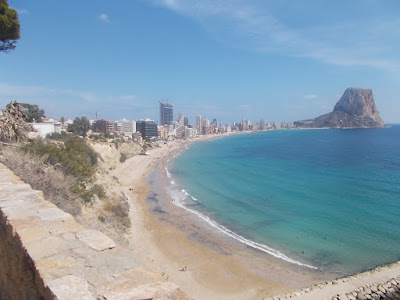



























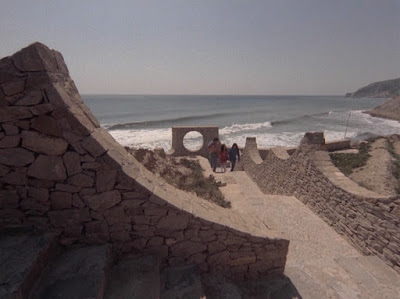













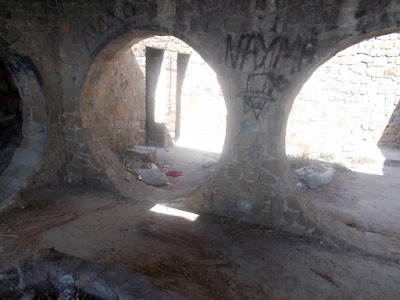
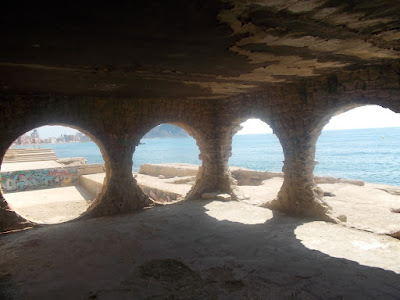










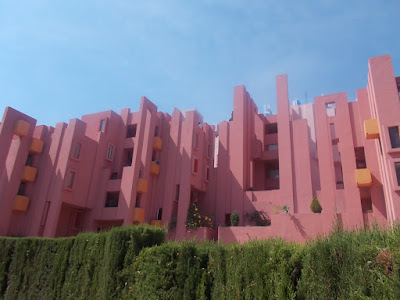














































7 comments:
Thank you for this extended photo essay. These locations seem to be out of a surrealist's fever dream and it's nice to see evidence that not only did they exist in the real world, but still do!
Keep up the good work!
Roger
Thanks for your research and all the exhaustive screengrab comparisons, this is simply wonderful!
A major and unique work. I've sent it to a massive Franco follower who met him and Lina in the States some years back. Did being in this surreal environment bring on an altered state of consciousness?
It's a disgrace that vandals spray graffiti. Fantastic work in this blog. I've never read a comprehensive article about Franco's use of Spanish locations.
The grafitti says something like "Til the moon (in the sense of "i'd go til the moon). Never forget, Moonface"
Thanks everyone for your comments, and I'm sorry for the delay in approving/replying - I've been away from the computer for a few days.
I'm really glad that these photos and location notes have proved interesting to people - I was worried that matching up photos with shots from the movies bordering on unhealthily obessive behaviour, but if nothing else, I think my efforts serve to reveal the amount of (often invisible) effort that Franco put into his cinematography, using distorting lenses, extreme low angles and careful framing to bring out a dream-like / surrealistic character in his locations that casual visitors to those remarkable buildings could easily miss.
I thoroughly enjoyed visiting Calpe all round actually -- scouting movie locations is great excuse to visit fascinating places that would often pass you by, and as I say, I'd love to arrange some similar trips in future.
If you look for new Franco locations, in his second Fu Manchu movie and his Dracula appear places of Barcelona and its surroundings: the park Güell, the Ciutadella gardens, the Pueblo Español or the Sant Cugat monastery.
Post a Comment